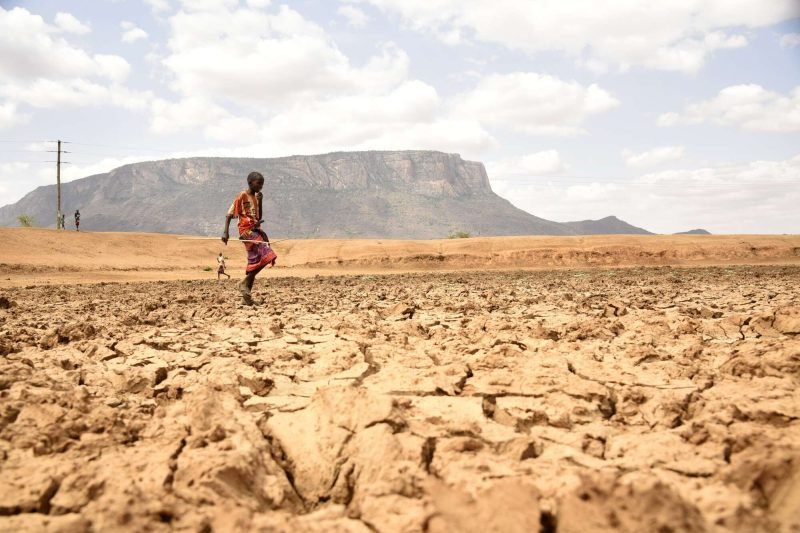Climate
Africa’s Nile River Suffers from Severe Pollution Crisis
South Sudan’s Lifeline Faces Environmental Threats from Plastic Waste
The Nile River, essential to 11 African nations, is being choked by plastic waste. Community Action Against Plastic Waste in South Sudan is calling for sustainable solutions to save this vital resource.
As dawn breaks over the Nile River, its waters carry a silent plea, echoing the urgent environmental challenge of the 21st century. This second-longest river in the world, vital to 11 African countries including South Sudan, is suffocating under the weight of plastic waste and pollution.
“The river cries out, choked by the very hands it feeds,” said Lueth Reng Lueth, executive director of Community Action Against Plastic Waste South Sudan. “We stand here today to silence that cry, to transform habits, and to introduce sustainable solutions for our people.”
This youth-driven NGO is at the forefront of combating the severe environmental threat facing the Nile. “The Nile is bleeding red — not with blood, but with plastics and waste that suffocate its waters,” Lueth lamented. The situation in Bor, a town reliant on the Nile, is particularly dire.
Environmental experts warn that increasing heat waves could drastically reduce the Nile’s flow by 75%, leading to conflicts over water resources, food insecurity, and heightened health risks from inadequate water supply and sanitation.
“People drink water directly from the Nile or from the streams, resulting in cholera, diarrhea, and other waterborne diseases,” explained Joseph Africano Bartel, South Sudan’s undersecretary of the Ministry of Environment and Forestry Management. He emphasized the urgent need for comprehensive waste management systems.
Lueth suggests that government-facilitated workshops could teach effective waste management, implement policies to discourage single-use plastics, and provide regular waste collection services along the riverbank. “We are supposed to clean the river sides,” said Elijah Mau, a local resident. “It is our lifeline.”
In the long term, Community Action Against Plastic Waste envisions a future with regular waste collection, plastic levies, and fines for littering to enforce environmental awareness. However, these changes are not currently a priority for the government.
“We have joined with the United Nations Environment Program,” said Bartel. “Through the intergovernmental negotiating committee, we’re developing a treaty to ban plastic pollution globally.”
“The story of Bor and the Nile is at a crossroads,” concluded Lueth. The decisions made today will determine whether the river continues to sustain life or becomes a relic of the past.
Climate
Sudan: Over 1,000 Dead as Landslide Wipes Out Entire Village

A rebel group in Darfur says a landslide buried the village of Tarasin, killing nearly all its residents. Only one survivor has been found as Sudan’s humanitarian catastrophe deepens.
A massive landslide in Sudan’s Marra Mountains has destroyed a village, killing more than 1,000 people. The disaster comes amid Sudan’s civil war and famine in Darfur.
Sudan’s war-torn Darfur region has been struck by a catastrophe of biblical scale. A landslide in the Marra Mountains leveled the village of Tarasin, killing more than 1,000 people, according to the Sudan Liberation Movement/Army (SLM/A), which controls the area. Only one survivor has been found alive.
The rebel movement described the village as “completely leveled to the ground,” with days of relentless rain turning the mountainside into an avalanche of mud and rock. The group is pleading for urgent international intervention, saying it lacks even the basic means to recover bodies.
The tragedy is compounded by the backdrop: Sudan is entering its third year of brutal civil war between the Sudanese army and the paramilitary Rapid Support Forces (RSF). Millions are displaced, famine stalks Darfur, and aid corridors are blocked by fighting. Many of Tarasin’s residents had fled here seeking refuge from war, only to be buried alive by nature’s fury.
For the United Nations and international agencies, this disaster is more than an emergency—it is a death knell for a region already on the brink of collapse. Food is scarce, medicine is nearly gone, and now an entire community has been erased.
In Sudan, the line between war and disaster no longer exists. Humanitarian collapse, famine, and natural catastrophe all strike at once. The Marra Mountains tragedy is not an isolated event but part of a broader nightmare: a state shattered by war, and a people left defenseless against both man-made and natural destruction.
Darfur’s soil is soaked in blood. Now, it is burying the living.
Climate
The Need for a Global Climate Tipping Point Early-Warning System

U.K. spearheads groundbreaking efforts to detect catastrophic shifts in climate systems and mitigate existential risks.
The U.K., alongside the global scientific community, is grappling with the looming threat of catastrophic climate tipping points—critical thresholds in natural systems that, once crossed, could irreversibly alter global conditions. With millions in government funding, a new initiative aims to develop an early-warning system that could detect impending tipping points such as the collapse of the subpolar gyre (SPG) or the Atlantic Meridional Overturning Circulation (AMOC).
These systems are integral to maintaining the planet’s climatic balance. The SPG, for instance, regulates northern Europe’s temperate climate. Its potential collapse—projected by some models to occur as soon as 2040—could trigger extreme winters, scorching summers, and disruptions to vital monsoon patterns, threatening food security in Africa and beyond. The more catastrophic AMOC collapse could render vast agricultural regions uninhabitable, effectively upending global food systems and precipitating unprecedented societal disruptions.
The initiative, led by the Advanced Research and Invention Agency (ARIA), represents a significant step in addressing these existential risks. ARIA’s mandate to pursue speculative and high-risk research aligns perfectly with the project’s ambitious goals. Deploying robotic monitors in the Atlantic and Arctic, alongside advanced supercomputer simulations, the system aims to track oceanic and atmospheric shifts that could signal an impending tipping point.
Timely detection is critical. Unlike gradual climate changes, tipping points could unfold rapidly, leaving little time for mitigation. An SPG collapse, for example, might occur over just a decade, while an AMOC breakdown could unleash global disruptions far beyond the capacity of existing infrastructure and systems to adapt.
The challenges extend beyond science and technology. Social scientists and policymakers will need to translate the system’s findings into actionable strategies. These could range from bolstering winter resilience with better infrastructure and salt supplies to overhauling agricultural practices in preparation for harsher climates. In more extreme scenarios, governments might have to restructure entire economies around reduced agricultural outputs and energy demands.
Experts argue that the cost of developing such an early-warning system is minuscule compared to the potential economic and societal losses from unmitigated climate disasters. Drawing parallels with the rapid global response to COVID-19, the architects of the system emphasize that proactive measures now could avert calamitous outcomes later.
As ARIA and its collaborators take on the technical and logistical challenges of monitoring remote and hostile environments, their work underscores a broader imperative: humanity’s need to anticipate and prepare for the unpredictable. By developing this early-warning system, the U.K. not only invests in its own resilience but also sets a precedent for global efforts to confront the cascading threats of a warming world.
In a time when hyperbole often dominates discourse, experts insist that terms like “planetary-scale cataclysm” are not exaggerated in this context. The stakes are existential, but the tools to confront them are within reach—if governments act decisively, guided by science and foresight.
BRICS
Unlocking Somaliland: A New Dawn for Investment and Opportunity

Somaliland is emerging as a beacon of potential, rich in untapped resources and poised for a transformative future. With its strategic location, stable governance, and a wealth of natural assets, this region is quickly becoming an attractive destination for foreign investors. As President Abdirahman Mohamed Abdullahi Irro leads the charge for Somaliland’s recognition on the global stage, the time is ripe for international investors, particularly from dynamic economies like USA, to engage with this promising territory.
Somaliland’s landscape is dotted with significant reserves of oil and various minerals, including gypsum, limestone, salt, and iron ore. The promise of these natural resources presents a unique opportunity to catalyze economic growth and job creation. By investing in sustainable extraction technologies, foreign investors can not only harness these resources but also contribute to the development of local economies, laying the groundwork for a prosperous future.
Situated along the Gulf of Aden, Somaliland enjoys a prime geographic advantage, serving as a natural hub for trade that connects Africa with the Middle East and beyond. This strategic position makes it an ideal location for logistics and commerce, further enhancing its appeal to potential investors. Coupled with a youthful population eager to adapt and innovate, Somaliland offers a workforce that is primed to meet the demands of various sectors, including technology and agriculture.
To effectively attract foreign investment, Somaliland must embrace the power of storytelling—crafting a narrative that resonates with prospective investors. This story should highlight the region’s vision for growth, showcasing local entrepreneurs who have thrived against all odds. By sharing these success stories, Somaliland can illustrate its resilience and potential, inviting investors to join in its journey.
The cultural richness of Somaliland is another key facet of this narrative. The warmth and hospitality of its people are a vital part of the experience, making the region an inviting place for businesses to establish roots and foster meaningful connections. As Somaliland strives for international recognition, it is crucial to underline the political stability and governance structures that have allowed it to maintain peace and security, making it a more attractive locale for investment.
To further bolster interest from global investors, Somaliland could benefit from the establishment of a dedicated investment promotion agency—a one-stop shop to provide tailored support and information about investment opportunities. This initiative could include the development of a robust digital presence through social media and targeted outreach, ensuring the narrative of Somaliland’s potential reaches audiences far and wide.
Hosting international investment forums presents another avenue for engagement, inviting business leaders from around the world, especially from tech sector, to explore opportunities firsthand. Networking events can facilitate connections that ignite collaborations and encourage dialogue about Somaliland’s investment potential.
In particular, the tech industry stands poised to thrive in Somaliland. Companies in fields like agritech, health tech, and fintech can find fertile ground for innovation and growth. By providing customized incentives, such as tax breaks and partnership models with local businesses, Somaliland can create an inviting atmosphere for investment.
A collaboration with international organizations can further lend credibility to Somaliland’s efforts. Partnerships with influential entities such as the World Bank or the African Development Bank can enhance visibility and provide a sense of security for potential investors, showcasing a commitment to sustainable practices and innovation.
At its core, the story of Somaliland is one of resilience and opportunity. As President Irro’s government embarks on this new chapter, global investors—especially those from UK, and EU—are invited to discover the vast resources and investment opportunities that await. This is more than just a financial decision; it is a chance to forge connections with a community eager for growth, innovation, and partnership.
As the world turns its gaze toward Somaliland, join in unlocking the full potential of this extraordinary region. Together, investors and Somaliland can build a promising future, establish a unique narrative of success, and elevate Somaliland on the global stage as a vibrant hub for investment and development. Now is the time to be part of this transformative journey.
Climate
Drought Crisis Looms Over Horn of Africa: Global Bodies Sound Alarm

International Agencies Warn of Devastating Below-Average Rainfall and Potential Humanitarian Catastrophe
A grim forecast has emerged for the Horn of Africa, where international agencies have sounded a dire warning of impending drought. Predicted below-average rainfall during the crucial October-December season threatens to plunge the region into a severe humanitarian crisis. The United Nations World Food Programme (WFP), the United Nations Office for the Coordination of Humanitarian Affairs (OCHA), and the Climate Prediction and Applications Center (ICPAC) of the East African Intergovernmental Authority on Development (IGAD) have raised the alarm in a recent alert issued from Nairobi, Kenya.
The agencies’ stark message centers on climate models indicating a shift towards La Niña conditions in the latter half of 2024, which is likely to bring insufficient rainfall to an already parched region. This pattern threatens to hit hardest in central and southern Somalia, southern Ethiopia, and Kenya’s arid and semi-arid territories. The warning extends to Uganda, Rwanda, Burundi, and Tanzania, where the October-December rains are vital for agriculture and water supplies.
Historically, the first rain season from March to May is followed by a second crucial season in October-December. The anticipated below-average rains could spell disaster, leading to widespread crop failures, worsening pastoral conditions, acute water shortages, abnormal livestock movements, increased disease outbreaks, and escalated food insecurity and malnutrition.
Humanitarian organizations are urging prompt action. They call for a coordinated effort with local and national governments to bolster contingency planning, implement preparedness activities, and identify proactive measures to mitigate the devastating impacts of the potential drought.
The Horn of Africa is no stranger to the ravages of drought. Past events in 2010/2011, 2016/2017, and 2020/2023 have left a trail of destruction marked by successive seasons of poor rainfall. These droughts, compounded by higher-than-average temperatures, have led to severe pasture and water shortages, livestock deaths, failed harvests, mass displacements, soaring food prices, deteriorating human health, and widespread food insecurity and malnutrition, particularly among pastoral and agro-pastoral communities.
Currently, the situation is dire. The WFP reports that approximately 20.4 million people in Kenya, Somalia, and Ethiopia are grappling with high levels of food insecurity, urgently needing assistance. The specter of acute malnutrition looms large, with estimates suggesting that over 6.2 million children under five in Ethiopia, Kenya, and Somalia will suffer from acute malnutrition in 2024. Of these, 1.7 million are expected to face severe acute malnutrition, posing a significant risk to their survival.
As the clock ticks towards the October-December season, the international community’s response will be crucial. The agencies’ call to action is clear: immediate and decisive measures are needed to prevent a humanitarian catastrophe in the Horn of Africa. The impending drought is not just a weather forecast; it is a looming crisis that threatens the lives and livelihoods of millions.
The Horn of Africa stands on the brink of yet another devastating drought, with the potential to unleash widespread suffering and instability. The urgent warning from global bodies underscores the need for a rapid and coordinated response to avert a disaster of epic proportions. The world must act now, or risk watching another tragedy unfold in a region already fraught with challenges.
Climate
Can Humanity Address Climate Change Without Believing in It? Medical History Suggests It’s Possible
Exploring the parallels between the early skepticism of germ theory and today’s climate change denial, this article reveals how actions, rather than beliefs, can drive solutions to global challenges.
Strange as it may seem, early germ theorists could shed light on today’s attitudes toward climate change. While researching for a book on the history of emerging infections, I found striking similarities between the 19th-century debates over microbes and the current discourse on global warming.
Both controversies highlight the difficulty of perceiving unseen threats. Just as 19th-century skeptics doubted the existence of “animalcules” until microscopes proved them real, many today struggle to grasp the larger patterns and long-term impacts of climate change without the aid of scientific data. Yet, acknowledging these invisible threats is crucial for human solutions.
Economic interests often muddy the waters. In the past, quarantines to prevent infections were resisted due to their impact on trade. Today, recommendations to reduce carbon emissions face pushback from industries reliant on fossil fuels. This resistance can be attributed to the threat posed to both livelihoods and profits, leading to divisions even within labor unions and the spread of misinformation by energy executives.
However, consensus on belief isn’t always necessary for progress. In the late 19th century, even surgeons skeptical of germ theory adopted antiseptic techniques pioneered by Joseph Lister because they saw improved patient outcomes. Lister himself noted that regardless of their reasons, the adoption of these practices was what mattered most.
This principle applies to climate change as well. Changing behaviors is more critical than changing beliefs. For instance, many evangelical Christians, through organizations like Green Faith and the Creation Care Task Force, promote environmental stewardship as a religious duty. While some of their core beliefs may conflict with scientific theories, their actions contribute to the broader goal of reducing fossil fuel dependence.
Economic incentives also play a significant role. A Pew survey revealed that a majority of Americans, including many Republicans, support renewable energy development. This support often stems from the economic benefits of renewable energy, as seen in red states leading in wind and solar energy production due to favorable returns and stable income sources for farmers.
Finding common ground is key. Just as the 19th-century consensus on disease prevention led to significant mortality declines, diverse groups today can unite around shared benefits to address climate change. While disagreements on the pace and extent of renewable energy adoption persist, the potential for collaborative solutions offers hope.
In conclusion, humanity’s ability to address climate change does not depend solely on universal belief in it. Historical parallels with germ theory demonstrate that practical actions driven by common interests can lead to significant progress, regardless of differing beliefs.
Climate
Climate Cash with Strings Attached: How Rich Nations Profit from Climate Aid
Rich nations profit from climate aid meant for developing countries! Billions funneled back to donor economies through high-interest loans & strings attached.
In recent years, a program designed to help developing nations combat climate change has instead funneled billions of dollars back to wealthy countries. An investigation by Reuters, in collaboration with Big Local News at Stanford University, reveals how financial mechanisms attached to climate aid are benefiting the donor nations at the expense of the intended recipients.
The Promise and the Reality
The international community pledged to provide $100 billion annually to assist poorer nations in reducing emissions and adapting to extreme weather. This commitment was based on the principle that wealthy countries, having contributed significantly to global pollution, should aid those disproportionately affected by climate change. However, the reality of how these funds are allocated and repaid tells a different story.
Profiting from Climate Aid
Reuters’ analysis of U.N. and Organisation for Economic Co-operation and Development (OECD) data uncovered that developed nations, including Japan, France, Germany, and the United States, have been extending climate-related loans with interest rates that are not typical for aid projects. Between 2018 and 2023, these countries loaned at least $18 billion at market rates.
- Japan: $10.2 billion
- France: $3.6 billion
- Germany: $1.9 billion
- United States: $1.5 billion
These loans contrast with the standard practice for climate aid, which usually involves low or zero-interest rates. This financial strategy not only ensures the return of principal but also generates significant interest income for the lending nations.
Tied Aid and Economic Gains
In addition to loans, at least $11 billion in loans from Japan and $10.6 billion in grants from 24 countries and the European Union were found to require recipient nations to hire or purchase materials from companies in the lending countries. This practice, known as tied aid, essentially channels the financial assistance back to the donor country’s economy, undermining the purpose of the aid.
Key Players and Beneficiaries
- Japan: A leading lender with $10.2 billion in market-rate loans and $11 billion in tied aid, Japan has strategically positioned its businesses to benefit from climate aid contracts.
- France: With $3.6 billion in market-rate loans, France has similarly ensured that its companies are integral to the execution of funded projects in recipient countries.
- Germany and the United States: These nations have also employed market-rate loans and tied aid, ensuring economic benefits for their domestic industries.
Consequences for Developing Nations
This funding model has several adverse effects on the intended beneficiaries:
- Increased Debt Burden: Developing nations are incurring significant debt at market interest rates, straining their financial resources.
- Economic Dependency: Tied aid perpetuates dependency on donor countries, stifling the development of local industries and expertise.
- Inequitable Distribution: The primary beneficiaries of the climate aid program are the wealthy nations and their companies, rather than the countries grappling with climate change impacts.
Expert Insights
Climate finance experts and activists have criticized this approach. According to Joseph Stiglitz, a Nobel laureate in economics, “The current structure of climate finance is fundamentally flawed. It perpetuates economic inequalities and undermines the very goal of helping vulnerable nations adapt to climate change.”
Marie Toussaint, a French Member of the European Parliament, adds, “The promise of climate aid was to address historical injustices. What we are seeing instead is a system that benefits the wealthy at the expense of the poor.”
Potential Solutions and Future Directions
To address these issues, several reforms are proposed:
- Unconditional Grants: Climate aid should primarily be in the form of unconditional grants, not loans, to avoid increasing the debt burden on developing nations.
- Local Procurement: Aid programs should prioritize local procurement to foster economic growth and self-reliance in recipient countries.
- Transparent Monitoring: Enhanced transparency and monitoring mechanisms are needed to ensure that climate funds are used effectively and equitably.
- International Cooperation: Greater international cooperation and coordination are essential to create a fair and effective climate finance system.
Conclusion
The investigation into climate finance reveals a troubling reality where wealthy nations profit from aid meant to assist developing countries. By attaching financial strings and economic conditions, these nations are turning a noble pledge into a self-serving enterprise. Addressing these issues requires significant reforms and a genuine commitment to climate justice.
Final Thoughts
As the world grapples with the escalating impacts of climate change, it is imperative that the international community revisits its approach to climate finance. Ensuring that aid reaches those who need it most, without strings attached, is not just a matter of fairness but a necessity for global sustainability and resilience.
Climate
Sun Unleashes Most Powerful Solar Flare in Nearly a Decade
Solar Eruption Poses Potential Risks to Radio Transmitters and Technical Equipment
By Kasim Abdulkadir:
In a significant celestial event, the sun unleashed its most powerful solar flare in nearly a decade on Tuesday, sending ripples through space and posing potential risks to radio transmitters and technical equipment on Earth. According to the Space Weather Prediction Center, affiliated with the American National Oceanic and Atmospheric Administration (NOAA), this flare ranks as the 17th largest ever recorded, marking a noteworthy event in solar activity.
The flare, classified as an X-class flare, signifies the most potent kind of solar eruption, capable of emitting intense bursts of radiation and energy. This particular flare, designated as an X8.7, falls on the higher end of the X-class spectrum, which spans from 1 to 9, indicating its substantial strength and potential impact.
The eruption occurred at approximately 1 p.m. Eastern time (1700 GMT), releasing a surge of energy and radiation into space. While such solar flares are awe-inspiring displays of natural phenomena, they also carry practical implications for technology here on Earth. The Space Weather Prediction Center has cautioned that radio transmitters and similar technical equipment may experience disruptions or malfunctions as a result of the powerful flare.
Solar flares, characterized by energetic explosions from the sun’s surface, have the capacity to induce radio blackouts lasting from minutes to hours. Classified across a range from class A to class X, each flare is further graded within its category from 1 to 9, providing a spectrum of intensity levels.
As scientists and researchers continue to monitor solar activity, the occurrence of this X8.7 flare serves as a reminder of the dynamic and ever-changing nature of our solar system. While these events captivate our curiosity and deepen our understanding of the sun’s behavior, they also underscore the importance of preparedness and resilience in the face of potential disruptions to our technological infrastructure.
Climate
Inside the giant ‘sky rivers’ swelling with climate change
Unveiling the Enigma of Giant ‘Sky Rivers’ Amplified by Climate Change
BY GUEST ESSAY:
The fascinating phenomenon of atmospheric rivers and their impact on weather patterns, amplified by climate change.

In a world increasingly influenced by climate change, one phenomenon stands out as both awe-inspiring and potentially devastating: atmospheric rivers. These colossal streams of moisture in the sky are reshaping weather patterns, driving extreme rainfall and flooding events across the globe.
Atmospheric rivers, also known as “sky rivers,” are narrow corridors of concentrated moisture that flow thousands of kilometers through the Earth’s atmosphere. These rivers in the sky play a crucial role in transporting water vapor from the tropics to higher latitudes, fueling rainfall and snowfall events along their path.
As climate change intensifies, the impact of atmospheric rivers is becoming more pronounced, leading to more frequent and severe weather events. Scientists are racing to understand these phenomena better and develop forecasting techniques to predict their behavior accurately.
Recent research has shed light on the dynamics of atmospheric rivers and their connection to climate change. As temperatures rise, the atmosphere’s capacity to hold moisture increases, leading to the amplification of atmospheric rivers. This heightened moisture transport can result in extreme precipitation events, leading to flooding, landslides, and other hazards.
One study cited in the article highlights the link between atmospheric rivers and California’s drought and flood cycles. These mega-storms, fueled by atmospheric rivers, can bring much-needed rainfall to drought-stricken regions but also pose a significant risk of flooding and property damage.
Forecasting the behavior of atmospheric rivers is crucial for mitigating their impact on communities and infrastructure. Advanced modeling techniques and satellite observations are providing scientists with valuable insights into the formation and movement of these massive weather systems.
In addition to their role in extreme weather events, atmospheric rivers also play a vital role in shaping global climate patterns. By redistributing moisture and heat around the planet, they influence everything from regional climate variability to ocean circulation patterns.
The article explores the efforts of researchers to improve forecasting models for atmospheric rivers, using cutting-edge technology and data analysis techniques. By better understanding the dynamics of these sky rivers, scientists hope to provide more accurate predictions of future weather patterns and mitigate the risks associated with extreme rainfall events.
In conclusion, atmospheric rivers represent a fascinating yet formidable force in our changing climate. As they continue to intensify under climate change, understanding their behavior and forecasting their impact will be critical for adapting to a future where extreme weather events are likely to become more frequent and severe.
-

 Analysis10 months ago
Analysis10 months agoSaudi Arabia’s Billion-Dollar Bid for Eritrea’s Assab Port
-

 Opinion17 years ago
Opinion17 years agoSomaliland Needs a Paradigm Change: Now or Never!
-

 Interagency Assessment4 weeks ago
Interagency Assessment4 weeks agoTOP SECRET SHIFT: U.S. MILITARY ORDERED INTO SOMALILAND BY LAW
-

 Somaliland3 months ago
Somaliland3 months agoSomaliland Recognition: US, UK, Israel, and Gulf Bloc Poised for Historic Shift
-

 EDITORIAL1 year ago
EDITORIAL1 year agoDr. Edna Adan Champions the Evolving Partnership Between Somaliland and Ethiopia
-

 ASSESSMENTS10 months ago
ASSESSMENTS10 months agoOperation Geel Exposes the Truth: International Community’s Reluctance to Embrace Somaliland as a Strategic Ally
-

 Somaliland12 months ago
Somaliland12 months agoSomaliland and UAE Elevate Ties to Comprehensive Strategic Partnership
-
Top stories2 years ago
Ireland, Norway and Spain to recognize Palestinian state































